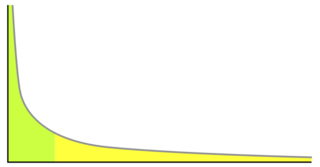In English, they are called “desire lanes,” but I like the Dutch name most: “elephant paths.” You find them when pedestrians or cyclists take a shorter route than they were supposed to take, creating an unplanned small trail. Once the path starts to emerge through the natural vegetation, more and more individuals will start to use them.
Basically, we tend to opt for a convenient shortcut even though other routes are perfectly possible or even pointed out to us. These “elephant paths” are fascinating, as they show how crowds decide on their own route and are not dictated by what the formal route ought to be.
It is not just us, as pedestrians and cyclists, that take these shortcuts. We all take elephant paths whenever we can. And not just the physical ones but–and particularly so–the mental ones. These elephant paths can be captured in laws, in principles of human behavior.

Zipf’s Law states that the frequency of words in a language follows a power law. That is, the most frequent word in a language, for instance, the determiner “the,” appears about twice as often as the second most frequent word, for instance, the preposition “to,” which appears twice as often as the third most frequent word “and.” This principle repeats itself over all the words in the language. The word in the position n appears 1/n times as often as the most frequent one. So you will find the word “unintelligible” at the far end tail of the curve, whereas “of,” “to,” “and” “you” appear at the very top of the curve.
What is fascinating about Zipf’s Law is that it does not only occur in the English language but in any language. And it does not just appear in language, but in any text, from a novel to a textbook, from a newspaper article to a blog. So take the words of this blog, get the frequency, and the most frequent word appears twice as often as the second most frequent word.

The interesting aspect of Zipf’s law is what is useful for any power law. Even though language users have the availability to all the words in a language, we follow the elephant path and use some words far more frequently than the other words.
We use 20 percent of the words 80 percent of the time. There are so many words that we could use, but we hardly ever do. We only use the ones at the top of the curve and the large tail (illustrative for a power law curve) we don’t really bother with. That may be an important hint to any language teacher and a relief for the language learner: rather than learning all the words in a language, you really only need to be worried about learning the most frequent 20 percent.
There is another law of human language behavior affiliated with Zipf’s Law. The words we use most frequently tend to be the shortest. Even though we could use longer words, we choose the elephant path and the shorter ones more often. The word “however” could be used, but we more readily go for “but.” Shorter words are more frequent than longer words, and less frequent words are longer. Not only in the words we use but also in the length of the words we use, we follow elephant paths.
Recently we found out that Zipf’s law is not only a matter of words. It is a matter of practically all aspects of language. Let’s take a conversation between two people. We can count the utterances that are used in a conversation between two people. What we find is that the most common utterance (“uh-huh) appears about twice as often as the second most common utterance, which appears twice as often as the third most common utterance. If we don’t focus on the entire utterance, but only on the first word of the utterance, the same is true.
The first word of the utterance is used twice as often as the second most frequent first word. And unsurprisingly, if we focus on the last word of the utterance, the same is still true. No matter what expect of the conversation we focused on, Zipf’s Law ruled.
But Zipf’s Law also shows to be dynamic. It turns out that when we are stressed–because we have to think harder or because the environment requires us to pay more attention–we are more likely to follow the elephant path.
We follow the principle of least effort, so much so that the power law becomes steeper as a function of cognitive effort. These are three laws of human behavior and three examples of elephant paths of the mind.
"behavior" - Google News
September 16, 2022 at 03:42AM
https://ift.tt/Ebav9mH
Laws of Human Behavior - Psychology Today
"behavior" - Google News
https://ift.tt/9CNxUsB
Bagikan Berita Ini














0 Response to "Laws of Human Behavior - Psychology Today"
Post a Comment